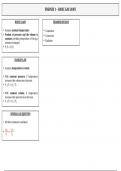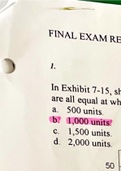Lote
AQA GCSE Biology
AQA A level Biology Revision Questions with certified Answers
[Mostrar más]AQA A level Biology Revision Questions with certified Answers
[Mostrar más]Natural Hazard - A natural hazard is a natural process which could cause death, injury or disruption to humans, or destroy proprty or posesions. Natural disaster - A natural hzard that has actualy happened Geological hazards - Caused by kand and tectonic processes Meteorological hazards - Caused...
Vista previa 2 fuera de 14 páginas
Añadir al carritoNatural Hazard - A natural hazard is a natural process which could cause death, injury or disruption to humans, or destroy proprty or posesions. Natural disaster - A natural hzard that has actualy happened Geological hazards - Caused by kand and tectonic processes Meteorological hazards - Caused...
Tough supporting wall of the eye - Sclera Transparent outer layer found at the front of the eye. Refracts (bends) light into the eye - Cornea Contains muscles that allow it to control the diameter of the Pupil (hole in the middle) and therefore how much light enters the eye - Iris Focuses light ...
Vista previa 1 fuera de 2 páginas
Añadir al carritoTough supporting wall of the eye - Sclera Transparent outer layer found at the front of the eye. Refracts (bends) light into the eye - Cornea Contains muscles that allow it to control the diameter of the Pupil (hole in the middle) and therefore how much light enters the eye - Iris Focuses light ...
What are the structures of an animal cell? - Nucleus, cytoplasm, cell membrane, mitochondria and ribosomes. What are the structures of a plant cell? - All structures from animal cells and cell wall, permanent vacuole and chloroplasts. What does the nucleus do? - Stores DNA and directs all cellul...
Vista previa 2 fuera de 15 páginas
Añadir al carritoWhat are the structures of an animal cell? - Nucleus, cytoplasm, cell membrane, mitochondria and ribosomes. What are the structures of a plant cell? - All structures from animal cells and cell wall, permanent vacuole and chloroplasts. What does the nucleus do? - Stores DNA and directs all cellul...
What are the structures of an animal cell? - Nucleus, cytoplasm, cell membrane, mitochondria and ribosomes. What are the structures of a plant cell? - All structures from animal cells and cell wall, permanent vacuole and chloroplasts. What does the nucleus do? - Stores DNA and directs all cellul...
Vista previa 2 fuera de 15 páginas
Añadir al carritoWhat are the structures of an animal cell? - Nucleus, cytoplasm, cell membrane, mitochondria and ribosomes. What are the structures of a plant cell? - All structures from animal cells and cell wall, permanent vacuole and chloroplasts. What does the nucleus do? - Stores DNA and directs all cellul...
What does a nucleus do? - It contains genetic material and controls the activities of the cell What does cytoplasm do? - It's a gel-like substance where most of the chemical reactions happen. It contains enzymes that control these chemical reactions What does a cell membrane do? - It holds the c...
Vista previa 4 fuera de 37 páginas
Añadir al carritoWhat does a nucleus do? - It contains genetic material and controls the activities of the cell What does cytoplasm do? - It's a gel-like substance where most of the chemical reactions happen. It contains enzymes that control these chemical reactions What does a cell membrane do? - It holds the c...
What is homeostasis? - The maintenance of a constant internal environment. What is a stimulus? - A change in your environment than requires a response. e.g Light, sound, touch, pressure, pain, chemical or temperature. What do the receptors do? - Detect the stimulus or change in environment. What...
Vista previa 4 fuera de 37 páginas
Añadir al carritoWhat is homeostasis? - The maintenance of a constant internal environment. What is a stimulus? - A change in your environment than requires a response. e.g Light, sound, touch, pressure, pain, chemical or temperature. What do the receptors do? - Detect the stimulus or change in environment. What...
How is the real size of a magnified image calculated? - Real size = Image size ÷ Total magnification. What is a eukaryotic cell? - A cell with DNA inside a membrane bound nucleus. Prokaryotic cells do not have a nucleus. Name two differences between a plant cell and a bacterial cell? - Plant ce...
Vista previa 1 fuera de 3 páginas
Añadir al carritoHow is the real size of a magnified image calculated? - Real size = Image size ÷ Total magnification. What is a eukaryotic cell? - A cell with DNA inside a membrane bound nucleus. Prokaryotic cells do not have a nucleus. Name two differences between a plant cell and a bacterial cell? - Plant ce...
How is the real size of a magnified image calculated? - Real size = Image size ÷ Total magnification. What is a eukaryotic cell? - A cell with DNA inside a membrane bound nucleus. Prokaryotic cells do not have a nucleus. Name two differences between a plant cell and a bacterial cell? - Plant ce...
Vista previa 1 fuera de 3 páginas
Añadir al carritoHow is the real size of a magnified image calculated? - Real size = Image size ÷ Total magnification. What is a eukaryotic cell? - A cell with DNA inside a membrane bound nucleus. Prokaryotic cells do not have a nucleus. Name two differences between a plant cell and a bacterial cell? - Plant ce...
What are cells? - The building blocks of organisms Define eukaryotic cell - Cells that have a true nucleus Define prokaryotic cell - Cells that do not have a true nucleus What is in an animal cell? - Nucleus, cytoplasm, cell membrane, mitochondria, ribosomes What is in a plant cell? - Same as an...
Vista previa 2 fuera de 6 páginas
Añadir al carritoWhat are cells? - The building blocks of organisms Define eukaryotic cell - Cells that have a true nucleus Define prokaryotic cell - Cells that do not have a true nucleus What is in an animal cell? - Nucleus, cytoplasm, cell membrane, mitochondria, ribosomes What is in a plant cell? - Same as an...
describe and explain the steps in the light dependent reaction of photosynthesis - 1. photoionisation: light reaches chlorophyll in PSII, which is absorbed by an electron, which becomes excited and moves to a higher energy level. 2. the electron passes to a carrier protein in the thylakoid membra...
Vista previa 3 fuera de 20 páginas
Añadir al carritodescribe and explain the steps in the light dependent reaction of photosynthesis - 1. photoionisation: light reaches chlorophyll in PSII, which is absorbed by an electron, which becomes excited and moves to a higher energy level. 2. the electron passes to a carrier protein in the thylakoid membra...
large molecules often contain carbon. why? - they can readily form bonds with other carbon atoms. this forms a 'backbone'. other atoms can then attach. describe benedicts test for reducing sugars - add equal volumes of the sugar sample and benedicts reagent. heat the mixture in a water bath fo...
Vista previa 3 fuera de 23 páginas
Añadir al carritolarge molecules often contain carbon. why? - they can readily form bonds with other carbon atoms. this forms a 'backbone'. other atoms can then attach. describe benedicts test for reducing sugars - add equal volumes of the sugar sample and benedicts reagent. heat the mixture in a water bath fo...
Describe how you would use a biochemical test to show that a solution contained a non-reducing sugar, such as sucrose. [3] - ,first reducing sugars test; boil with dilute HCl acid then Neutralise with NaHCǑ, add benedict and heat to 95 degrees C brick red ppt forms if reducing sugar is present D...
Vista previa 4 fuera de 82 páginas
Añadir al carritoDescribe how you would use a biochemical test to show that a solution contained a non-reducing sugar, such as sucrose. [3] - ,first reducing sugars test; boil with dilute HCl acid then Neutralise with NaHCǑ, add benedict and heat to 95 degrees C brick red ppt forms if reducing sugar is present D...
What are chromosomes? - They are really long molecules of DNA What does DNA stand for - DeoxyribonNucleicAcid. It is a complex chemical in a thread-like chain. It contains coded information and genetic information Where is DNA found - It is found in the nucleus of animal and plant cells in long s...
Vista previa 2 fuera de 13 páginas
Añadir al carritoWhat are chromosomes? - They are really long molecules of DNA What does DNA stand for - DeoxyribonNucleicAcid. It is a complex chemical in a thread-like chain. It contains coded information and genetic information Where is DNA found - It is found in the nucleus of animal and plant cells in long s...
What are the two types of microscopes? - Light Microscope Electron Microscope What is the magnifying power of a light microscope? - x 2,000 What is the magnifying power of an electron microscope? - x 2,000,000 What is the resolving power? - The ability to distinguish between two separate points ...
Vista previa 4 fuera de 35 páginas
Añadir al carritoWhat are the two types of microscopes? - Light Microscope Electron Microscope What is the magnifying power of a light microscope? - x 2,000 What is the magnifying power of an electron microscope? - x 2,000,000 What is the resolving power? - The ability to distinguish between two separate points ...

Compradores de Stuvia evaluaron más de 700.000 resúmenes. Así estas seguro que compras los mejores documentos!

Puedes pagar rápidamente y en una vez con iDeal, tarjeta de crédito o con tu crédito de Stuvia. Sin tener que hacerte miembro.

Tus compañeros escriben los resúmenes. Por eso tienes la seguridad que tienes un resumen actual y confiable. Así llegas a la conclusión rapidamente!
You get a PDF, available immediately after your purchase. The purchased document is accessible anytime, anywhere and indefinitely through your profile.
Nuestra garantía de satisfacción le asegura que siempre encontrará un documento de estudio a tu medida. Tu rellenas un formulario y nuestro equipo de atención al cliente se encarga del resto.
Stuvia is a marketplace, so you are not buying this document from us, but from seller jessyqueen. Stuvia facilitates payment to the seller.
No, you only buy this summary for $55.52. You're not tied to anything after your purchase.
4.6 stars on Google & Trustpilot (+1000 reviews)
45,681 summaries were sold in the last 30 days
Founded in 2010, the go-to place to buy summaries for 15 years now








